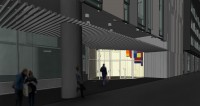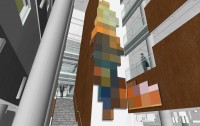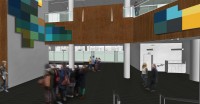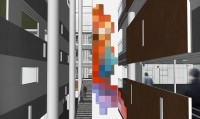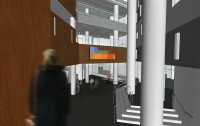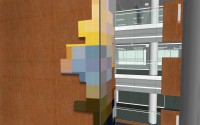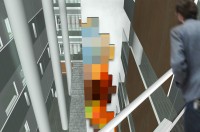Commissioned Second Stage Proposal, Public Art for the University of Ottawa’s New Learning Centre, 2016
Anima: LED video tiles, custom software, Mac mini computer, three PTZ network security cameras. See Animated Views in the video below.
Proposal excerpts:
Anima embodies the vitality of the University of Ottawa’s new Learning Center and the synergy between the Centre and the students and faculty who inhabit it. Dynamic compositions of colour-changing LED light pulse with the energy and motions of the people inside the building; their actions determine the varying pace and changing chroma of the moving square light pixels. Anima reacts to the presence of visitors in real time, employing video cameras and computer coding to analyze and extract the abstract qualities of their movements, colours and tempo for display in the lightworks. By visualizing the symbiotic relationship between the built space and its occupants, Anima accentuates their interaction and mutual animation.
The first component, LED tiles arranged across the interior vestibule wall, functions as an invitation to enter the building; as an introduction to the interactive art experience; and as a beacon when seen from the distance outside, later in the afternoon and evening. Upon entering the main floor atrium from the lobby, Anima’s principal installation comes into view, with tiles extending upwards to the fourth level on the south and west walls of the elevator shaft. The full impact of the piece is felt not only on the main floor, but from the upper storeys as well. Supplemental constellations of LED’s on the acoustic panels around the atrium extend the effect. The custom-shaped compositions of light pixels reflect the formal characteristics of crowd movement: in the same way that a flood of people entering the lobby gradually disperses as individuals head off to various parts of the building, the dense configuration of tiles concentrated on the narrow south elevator wall spreads out around the corner and into arrangements further afield. The groupings are irregularly shaped, steering away from the look of typical screens, to signal their identity as artworks. The changing coloured light activates the atrium space without filling it, creating a living, breathing presence that is both experiential and generative, never the same twice.
Anima’s abstracted imagery draws on alternating feeds from two indoor video cameras that track people’s movement along different axes of direction. One camera captures traffic passing mostly horizontally across the frame, while a second camera is positioned to track those traveling directly towards and away from the lens. At times we’re able to recognize our own colours and movements in the patterns of light squares, while at others, we’re made aware of what is happening elsewhere in the building. When students are rushing in and out as classes change, Anima’s surface is lively and animated. During quieter times in the hallways, as when most students are in class, slower, gentle transformations modify the light display. Even during interludes of calm, Anima is programmed to perpetually create new visual interest. A third video camera, with a view to outside, captures the seasonal colours of the trees, sky and street around the Learning Centre. Colour pixels randomly sampled from outdoors are continually inserted into the non-moving areas in the indoor camera feeds (where walls or furniture are in view). Further, pixels in areas of stillness are made to alter their colour slightly within a range of similar tones, so that the display shimmers with subtle colour variations. In this way, Anima breathes with the inner life of the building, be it active or tranquil.
Anima links the energy inside the building with that of the outside streetscape in two ways. By incorporating an outdoor-viewing camera feed, the colours of the surrounding environment are brought indoors into the lightwork. And, by broadcasting the “pulse” of the building out from the vestibule wall, Anima shares the Learning Centre’s internal life and activity level with observers and passersby on the street.
*Please note: the animations were created using a “screen capture” of the custom prototype computer program running on a laptop. The frame rate of the screen capture is lower than that of the actual output of the program. As a result, the motion in the animations seems ‘choppier’ than when the Anima program runs in real time, where the transitions between colours and the overall movement are smooth.
